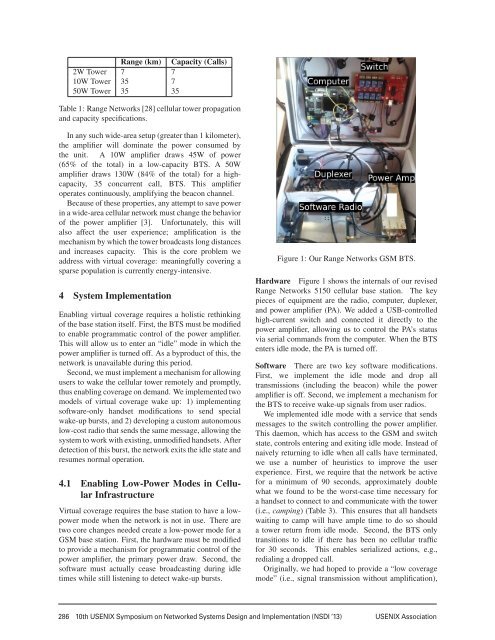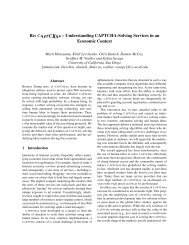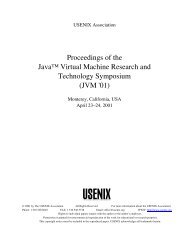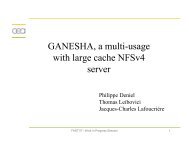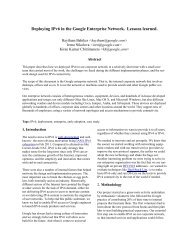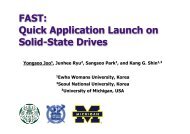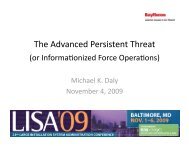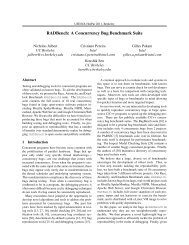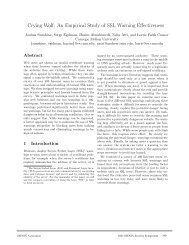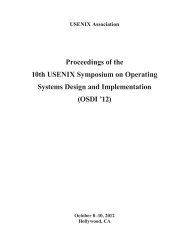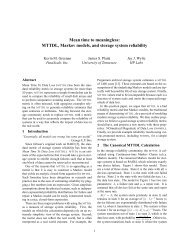Expanding Rural Cellular Networks with Virtual Coverage - Usenix
Expanding Rural Cellular Networks with Virtual Coverage - Usenix
Expanding Rural Cellular Networks with Virtual Coverage - Usenix
Create successful ePaper yourself
Turn your PDF publications into a flip-book with our unique Google optimized e-Paper software.
Range (km) Capacity (Calls)<br />
2W Tower 7 7<br />
10W Tower 35 7<br />
50W Tower 35 35<br />
Table 1: Range <strong>Networks</strong> [28] cellular tower propagation<br />
and capacity specifications.<br />
In any such wide-area setup (greater than 1 kilometer),<br />
the amplifier will dominate the power consumed by<br />
the unit. A 10W amplifier draws 45W of power<br />
(65% of the total) in a low-capacity BTS. A 50W<br />
amplifier draws 130W (84% of the total) for a highcapacity,<br />
35 concurrent call, BTS. This amplifier<br />
operates continuously, amplifying the beacon channel.<br />
Because of these properties, any attempt to save power<br />
in a wide-area cellular network must change the behavior<br />
of the power amplifier [3]. Unfortunately, this will<br />
also affect the user experience; amplification is the<br />
mechanism by which the tower broadcasts long distances<br />
and increases capacity. This is the core problem we<br />
address <strong>with</strong> virtual coverage: meaningfully covering a<br />
sparse population is currently energy-intensive.<br />
4 System Implementation<br />
Enabling virtual coverage requires a holistic rethinking<br />
of the base station itself. First, the BTS must be modified<br />
to enable programmatic control of the power amplifier.<br />
This will allow us to enter an “idle” mode in which the<br />
power amplifier is turned off. As a byproduct of this, the<br />
network is unavailable during this period.<br />
Second, we must implement a mechanism for allowing<br />
users to wake the cellular tower remotely and promptly,<br />
thus enabling coverage on demand. We implemented two<br />
models of virtual coverage wake up: 1) implementing<br />
software-only handset modifications to send special<br />
wake-up bursts, and 2) developing a custom autonomous<br />
low-cost radio that sends the same message, allowing the<br />
system to work <strong>with</strong> existing, unmodified handsets. After<br />
detection of this burst, the network exits the idle state and<br />
resumes normal operation.<br />
4.1 Enabling Low-Power Modes in <strong>Cellular</strong><br />
Infrastructure<br />
<strong>Virtual</strong> coverage requires the base station to have a lowpower<br />
mode when the network is not in use. There are<br />
two core changes needed create a low-power mode for a<br />
GSM base station. First, the hardware must be modified<br />
to provide a mechanism for programmatic control of the<br />
power amplifier, the primary power draw. Second, the<br />
software must actually cease broadcasting during idle<br />
times while still listening to detect wake-up bursts.<br />
Figure 1: Our Range <strong>Networks</strong> GSM BTS.<br />
Hardware Figure 1 shows the internals of our revised<br />
Range <strong>Networks</strong> 5150 cellular base station. The key<br />
pieces of equipment are the radio, computer, duplexer,<br />
and power amplifier (PA). We added a USB-controlled<br />
high-current switch and connected it directly to the<br />
power amplifier, allowing us to control the PA’s status<br />
via serial commands from the computer. When the BTS<br />
enters idle mode, the PA is turned off.<br />
Software There are two key software modifications.<br />
First, we implement the idle mode and drop all<br />
transmissions (including the beacon) while the power<br />
amplifier is off. Second, we implement a mechanism for<br />
the BTS to receive wake-up signals from user radios.<br />
We implemented idle mode <strong>with</strong> a service that sends<br />
messages to the switch controlling the power amplifier.<br />
This daemon, which has access to the GSM and switch<br />
state, controls entering and exiting idle mode. Instead of<br />
naively returning to idle when all calls have terminated,<br />
we use a number of heuristics to improve the user<br />
experience. First, we require that the network be active<br />
for a minimum of 90 seconds, approximately double<br />
what we found to be the worst-case time necessary for<br />
a handset to connect to and communicate <strong>with</strong> the tower<br />
(i.e., camping) (Table 3). This ensures that all handsets<br />
waiting to camp will have ample time to do so should<br />
a tower return from idle mode. Second, the BTS only<br />
transitions to idle if there has been no cellular traffic<br />
for 30 seconds. This enables serialized actions, e.g.,<br />
redialing a dropped call.<br />
Originally, we had hoped to provide a “low coverage<br />
mode” (i.e., signal transmission <strong>with</strong>out amplification),<br />
4<br />
286 10th USENIX Symposium on Networked Systems Design and Implementation (NSDI ’13) USENIX Association


